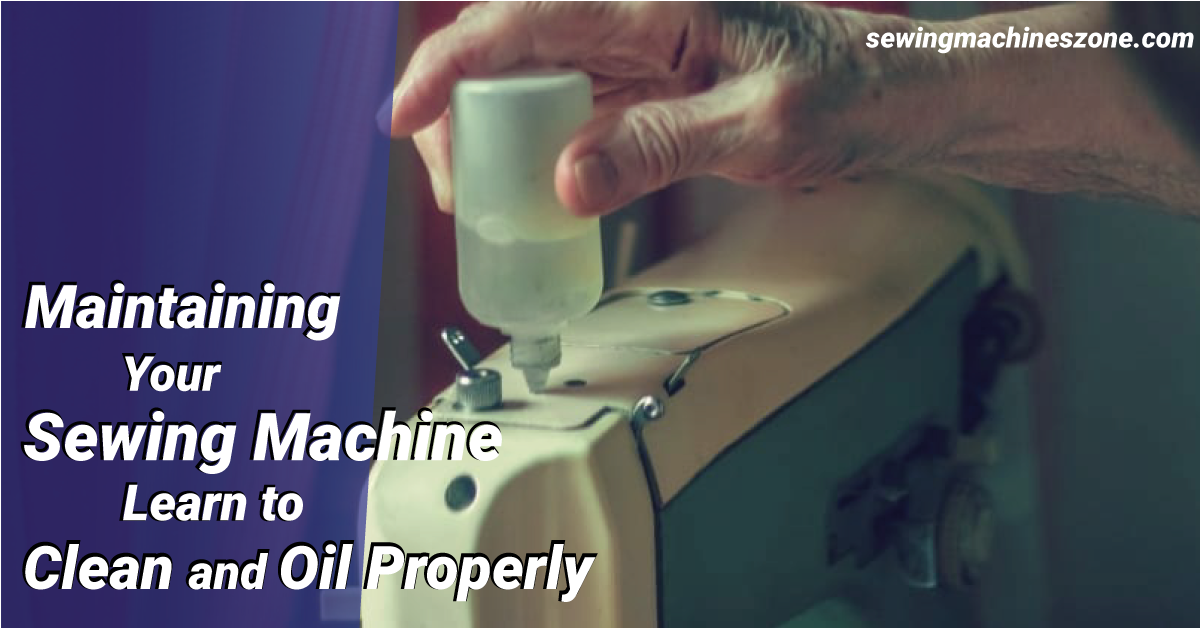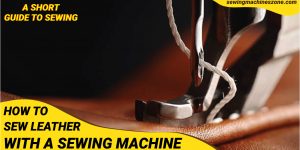A well-made sewing machine — serger or traditional, new or old, often used or only occasionally — will last you many years and sew well if it is properly and regularly taken care of.
It may need to be adjusted, or a part may need replacement, but a sewing machine that is given proper maintenance and cleaned regularly rarely “wears out.”
Sewing machines generally need basic maintenance of cleaning, oiling, and lubricating, but its extent depends on how you use the machine.
A tip to remember is to clean and oil your sewing machine based on how regularly you use it and the types of fabric you sew with. If you sew frequently, your machine will require frequent maintenance. Similarly, if you use fabrics that “shed” like velvet, you will need to do more frequent cleaning than when using other fabrics.
In short, if you use a sewing machine moderately or rarely, then your machine can survive being cleaned once every few months.
The rule of thumb is that if you see build-up or hear clinging or squeaking, then it is time for a refresh.
Are you interested in a more thorough guide? Then keep reading, because this article has a few useful suggestions for you!
And if you’re more interested in learning how to operate the Sewing Machine instead, feel free to visit this article: How To Sew Leather With A Sewing Machine?
Table Of Contents
GENERAL CLEANING
Here are several steps you can follow to rid your sewing machine of dirt and debris:
Step 1
The first step is to unplug your sewing machine. Next, to prepare your machine for cleaning, you have to remove the throat plate where most dust and fabric fibers accumulate.
You can read through your sewing machine’s manual to see how to remove the throat plate. A few machines come with a screwdriver that unscrews the plate, while others simply slide off.
Step 2
After removing the throat plate:
- Use a nylon brush to gather all the dust and reach all the little nooks and crannies.
- Remember not to use compressed canned air and blast inside your machine because it will further wedge the dirt and debris.
- If your machine has a bobbin case, take that out and clean it thoroughly.
Furthermore, be sure to get inside and in-between the feed dogs. You can use the end of a screwdriver to push out the dust or brush out with the nylon brush.
After the lower part of the sewing machine is cleaned, it is time to oil your machine.
OILING THE SEWING MACHINE
Sewing machine oils are used for lubricating sewing machines of all types and models. If used correctly, oiling can enhance the shelf life and performance of both home use and industrial-grade sewing machines.
Usually, sewing machine oil is made from common lubricants, such as petroleum products. Still, a variety of sewing machines oil alternatives, both artificial and natural, are available in the market. These are made from common sources such as coconut oil.
Once the sewing machine is free of lint and other dirty materials, you can start oiling it! Before starting the lubrication process, you must research the ingredients of the sewing machine oil you are using, as you will need to prepare the machine for oiling.
TYPES OF SEWING MACHINES OILS AND THEIR USES
- Mineral Oil
This type of oil is also called petroleum oil since it is made of various kinds of petrochemicals. Elements from crude oil are used to prepare it. That is why mineral oils are cheap and easily accessible to the masses.
If you want to keep the sewing machine maintenance on a tight budget, this oil is the best one for you! Along with the affordable price, mineral oils have other conveniences like being transparent and odorless.
As a result, you don’t have to worry about the oiling task being unpleasant for you through pungent smell. You can wear light-colored clothes while doing it since these oils don’t stain.
However, you must use these oils correctly. Applying mineral oil in the wrong places can do more harm than good to the machine.
- Natural Oil
Natural oils are the ideal choice for those who prefer the natural alternative and are conscious of environmental impacts. As the name suggests, these oils are made from natural ingredients like jojoba oils, ester oils, and silicone.
You can prepare the oil yourself by combining the following:
- 1 tbsp of ester oil
- 1 tbsp of silicon oil
- ⅓ cup of Jojoba oil.
However, relying on readymade natural oils is much safer since the homemade mixture has more room for error. Remember to first apply a drop of your DIY oil on the machine to see if there are any negative effects.
Compared to mineral oils or petrochemicals, natural oils are safer to use because they don’t have the dangers of similar health hazards.
- Synthetic Oil
Synthetic oils are good for sewing machines with plastic moving parts and steel or metal parts. This is the best oil among the three for such machines since the other two can’t work well for plastic material.
This oil can extend the durability of your machine by preventing the breakdown of threads. Another good aspect of this oil is that applying too much of it to the machine will not cause any damage.
Sewing Machine Oils Vs. 3 In One: Which One You Should Use?
The 3-in-1 oil is used for an array of purposes in households. You can use it for cleaning, lubrication, and protection of various domestic items. But is it a good idea to use 3-in-1 oil on your sewing machine?
Unfortunately, it is not at all recommended for oiling a sewing machine.
Several elements in the 3-in-1 oil vaporize after a while, and the sticky residue makes the machine even dirtier than before.
Avoid using it as a sewing machine oil and choose from the types discussed above.
By now, you must have chosen your most preferred oil out of all the options. Now it’s time to learn how to apply it!
Take it in a small bottle and prepare to lubricate your sewing machine in two very easy steps:
- Drops
Start applying the oil in drops to the places disclosed in your sewing machine manual. The common areas where the oil should reach include the bobbin case, shuttle hook, and the bobbin hook’s outer ring.
Squeeze one or two drops of oil in these sections and see if it needs more. If you are not using synthetic oil, don’t lubricate the plastic parts.
- Wipe Away Excess
After the machine parts have received enough oil, wipe off the excess with a small cloth. This step is important because the residual oil left there can later stain the fabric you work with.
Run the cloth through its parts and then rub the exterior. Use soap on the outer parts for the best results.
Re-installation and Testing
Once the oiling process is complete, it is time to put the detached parts back in place. After assembling the sewing machine fully, try it out for a test stitch to see if there is any unusual sound or stain on the working cloth. Wipe off the excess oil wherever it resides, and then sew away!
Of course, there are different kinds of machines, and different types have different specifications. Learn more about the many sewing machines in this guide: The Best Sewing Machines For Leather.
TIPS AND CAUTIONS FOR CLEANING A SEWING MACHINE
Here are some handy tips on cleaning and oiling the sewing machine to ensure the best results:
- If it is an electric sewing machine, disconnect its power sources before doing any of the steps. Otherwise, you may get injured from moving objects, such as needles.
- Never use all-purpose oil, motor oil, petroleum jelly, waxes, motor oil, or automotive lubricants for this job.
- If you don’t have any prior experience regarding this or don’t know what steps to follow for oiling the machine, take out the official manual provided with your sewing machine and clean as instructed.
- When you are cleaning the parts of your sewing machine with a compressed air can, hold its nozzle at a distance of at least 10 cm from the machine.
- Don’t disassemble the whole machine at a time. Separate only a few parts at one time so that you don’t struggle to reassemble it later.
The best thing to prevent dust and debris build-up in your sewing machine is to cover it when you are not using it. Your machine might come with a cover already, but you can also make your own.
CONCLUSION
Maintaining your sewing machine is as easy as one-two-three! It doesn’t require much time, and the benefits last you a long time.
With a machine that works smoother and faster, you can keep on doing more sewing projects. Apart from that, cleaning and oiling your machine yourself is very cost-effective! You save a lot of money by doing these easy steps yourself rather than hiring a professional cleaner.
Just oiling and cleaning every once in a while can extend the lifespan of your sewing machine and therefore give you the pleasure of creativity for a long time.
Try to do it today and see the improvement right away!
And if you haven’t bought your sewing machine yet, check out this article for the best information: What To Look For When Buying A Sewing Machine?








